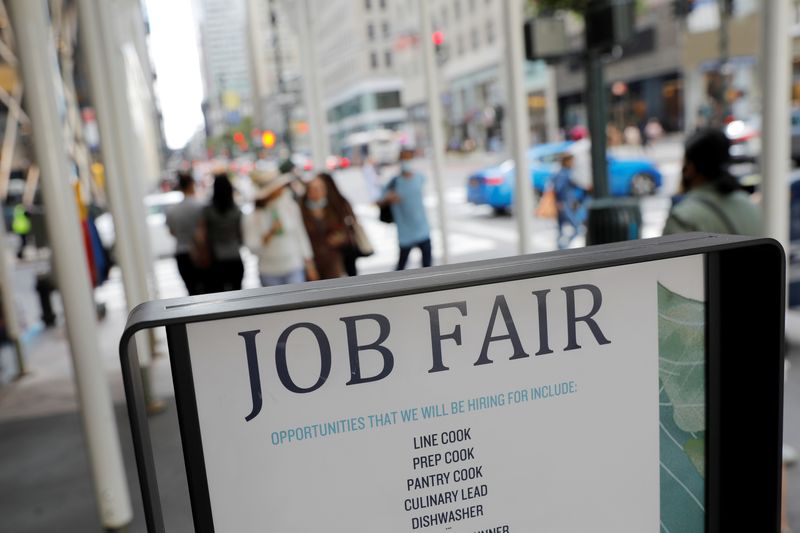By Lucia Mutikani
WASHINGTON (Reuters) - The number of Americans filing new applications for unemployment benefits fell to a seven-month low last week, suggesting that job growth likely rebounded in November after abruptly slowing last month amid hurricanes and strikes.
It is, however, taking longer for laid-off workers to find new jobs, posing an upside risk to the unemployment rate. The report from the Labor Department on Thursday also showed unemployment rolls swelling to levels last seen in late 2021.
Labor market slack keeps the door open to a third interest rate cut from the Federal Reserve next month, despite a recent lack of progress lowering inflation to its 2% target.
"There is little evidence of large layoffs taking place," said Gisela Hoxha, an economist at Citigroup (NYSE:C). "However, in a low hiring environment those individuals that are laid off are finding it harder to get a new job and are remaining on unemployment benefits for longer, which implies upside risk to the unemployment rate."
Initial claims for state unemployment benefits dropped 6,000 to a seasonally adjusted 213,000 for the week ended Nov. 16, the lowest reading since April. Economists polled by Reuters had forecast 220,000 claims for the latest week.
The data included the Veterans Day holiday, which could have injected some volatility.
Unadjusted claims decreased 17,750 to 213,035 last week. Filings in California dropped 4,657, almost reversing the prior week's 5,906 jump. The state offered no comment for that increase. There were also notable declines in applications in New Jersey, Ohio, Georgia, Texas and Indiana.
Filings had surged in New Jersey and Texas in the prior week, blamed on layoffs in the educational services industry as well as the healthcare and social assistance sector.
Though overall claims soared in early October amid disruptions caused by Hurricanes Helene and Milton as well as strikes by factory workers at Boeing (NYSE:BA) and another aerospace company, layoffs have remained low. That is softening the hit on the labor market from sluggish hiring.
The claims data covered the period during which the government surveyed businesses for the nonfarm payrolls component of November's employment report. Claims dropped by 29,000 between the October and November payrolls survey weeks.
Stocks on Wall Street traded higher. The dollar was steady against a basket of currencies. U.S. Treasury yields were little changed.
JOB GROWTH REBOUND EYED
Government data on Tuesday confirmed that Helene, Milton and the aerospace strikes had accounted for much of the sharp slowdown in job growth in October.
The state employment and unemployment report also showed the labor market steadily slowing. Economists estimated the strikes and storms probably subtracted between 100,000 and 125,000 jobs from payrolls last month.
Nonfarm payrolls increased by a scant 12,000 jobs in October, the fewest since December 2020, after rising by 223,000 in September. The Boeing strike ended early this month after workers accepted a new contract, while rebuilding is underway in the areas devastated by the hurricanes, creating a base of at least 100,000 jobs for November's payrolls.
Data next week on unemployment rolls could offer more clarity on the state of the labor market in November.
The number of people receiving benefits after an initial week of aid, a proxy for hiring, increased 36,000 to a seasonally adjusted 1.908 million during the week ending Nov. 9, the claims report showed.
The unadjusted so-called continuing claims increased 21,782 to 1.669 million. There was a sharp rise in Washington state, likely a residual from furloughs initiated by Boeing during the seven-week strike.
Continuing claims also rose substantially in Michigan, probably because of layoffs in the automobile industry. Economists dismissed a 15,357 plunge in Georgia as a fluke.
Some argued that the gap between the adjusted and unadjusted continuing claims suggested the latest rise was probably due to difficulties ironing out seasonal fluctuations from the data.
"Continuing claims have trended higher, which may suggest some slowing in re-hiring," said Conrad DeQuadros, senior economic advisor at Brean Capital. "But this could also be the product of inadequate seasonal adjustment factors."
The employment report for November could determine if the Fed cuts rates again in December. The U.S. central bank trimmed rates by 25 basis points earlier this month, lowering its benchmark overnight interest rate to the 4.50%-4.75% range.
The Fed embarked on its policy easing cycle with an unusually large half-percentage-point rate cut in September, its first reduction in borrowing costs since 2020. It hiked rates by 525 basis points in 2022 and 2023 to curb a surge in inflation.
There was a temporary respite for the housing market, which has borne the brunt of aggressive policy tightening.
Home sales jumped 3.4% in October to a seasonally adjusted annual rate of 3.96 million units after slumping to a 14-year low in September, the National Association of Realtors said in a separate report. Economists had forecast home resales rebounding to a rate of 3.93 million units.
Sales increased 2.9% year-on-year, the first annual gain since July 2021. October's homes sales likely reflected contracts signed in August and September, when mortgage rates were declining in anticipation of the Fed loosening policy.
Mortgage rates have erased all the decline since August as U.S. Treasury yields have risen on strong economic data and investor fears that President-elect Donald Trump's policies, including higher tariffs on imported goods and mass deportations, could reignite inflation.
Housing inventory stood at 1.37 million units in October, up 19.1% from one year ago. Despite the rise in supply, the median existing home price rose 4.0% from a year earlier to $407,200, the highest for any October.

At October's sales pace, it would take 4.2 months to exhaust the current inventory of existing homes, up from 3.6 months a year ago. A four-to-seven-month supply is viewed as a healthy balance between supply and demand.
"The renewed rise in mortgage rates through mid-November suggests that sales should remain sluggish through year-end even with availability perking up in many areas," said Ben Ayers, senior economist at Nationwide.